Making homemade glazed doughnuts is easier than you think, but requires a little patience. Ready in about 2.5 hours, these taste like doughnuts from your favorite bakery, but they’re made in the comfort of your own home. For doughnut success, follow my step-by-step photos, helpful success tips, and video tutorial. Using this same doughnut dough, you can create other flavored frosted doughnuts too!
I originally published this recipe in 2016 and have since added new photos, a video tutorial, and more helpful success tips.

With that signature bakery taste and texture, doughnuts from a doughnut shop are incredibly delicious and indulgent. When you can’t pick up your favorite doughnuts, why not make them at home instead? They’ve always been a baking bucket list recipe for me, and today I’m taking you on a deep dive into homemade doughnuts—fried, sugary, old-fashioned, and comforting. I originally shared this recipe in 2016, and I now have more step-by-step photos and a video tutorial to guide you.
There’s a lot to cover today, so let’s get started!
These Homemade Glazed Doughnuts Are:
- Soft and sweet
- Flavored with a little nutmeg
- Completely from scratch
- Ready in about 2.5 hours (most of this is rise time!)
- A fun and delicious weekend project
- Perfect for sharing
One reader, Sue, commented: “I just made these doughnuts. I usually make my grandmother’s old fashioned doughnuts, but these may be my new favorite. These are absolutely perfect. Easy to make. They are a hit! Five stars all the way! ★★★★★“
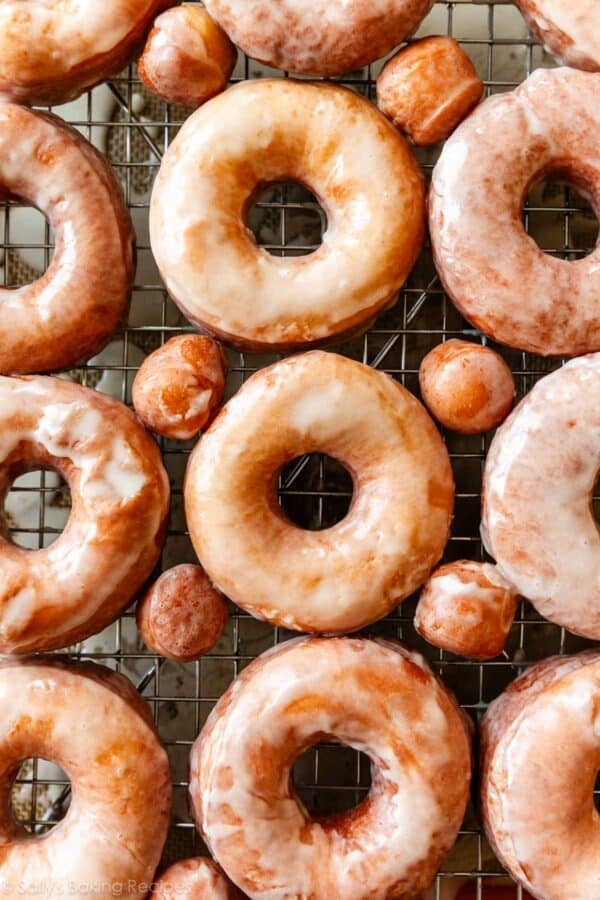
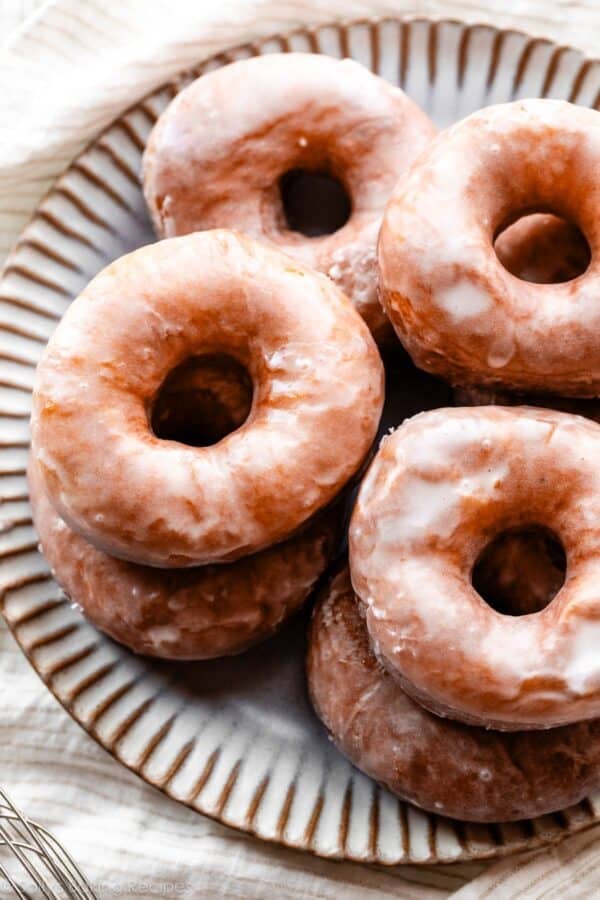
Best Ingredients to Use for Homemade Doughnuts
This is a straightforward, no-frills yeasted dough. You need just a few ingredients to begin:
- Milk: Liquid activates the yeast. Whole milk is a must for a super tender dough—or you can try buttermilk. Lower-fat or nondairy milks work in a pinch, but the doughnuts aren’t as flavorful or rich.
- Yeast: You can use active dry yeast or instant yeast. If using an instant yeast, your rise time will be a little shorter.
- Sugar: Sugar sweetens the doughnuts, but it also feeds the yeast, increases its activity, and tenderizes the dough.
- Eggs: Eggs provide structure and flavor.
- Butter: Melted butter promises enhanced flavor.
- Salt & Vanilla Extract: Both add flavor. You could even try using homemade vanilla extract!
- Nutmeg: A little nutmeg is the secret ingredient to that cozy, comforting bakery taste. If you’ve ever made my chocolate chip muffins, you know it adds a delicious pop of flavor!
- Flour: All-purpose flour is the dough’s structure. You’ll be tempted to add more and more flour as you mix the dough, but don’t. You want a very soft, pillowy dough for soft, pillowy doughnuts. The dough can still be slightly sticky. When kneading, use extra flour on your hands and work surface.
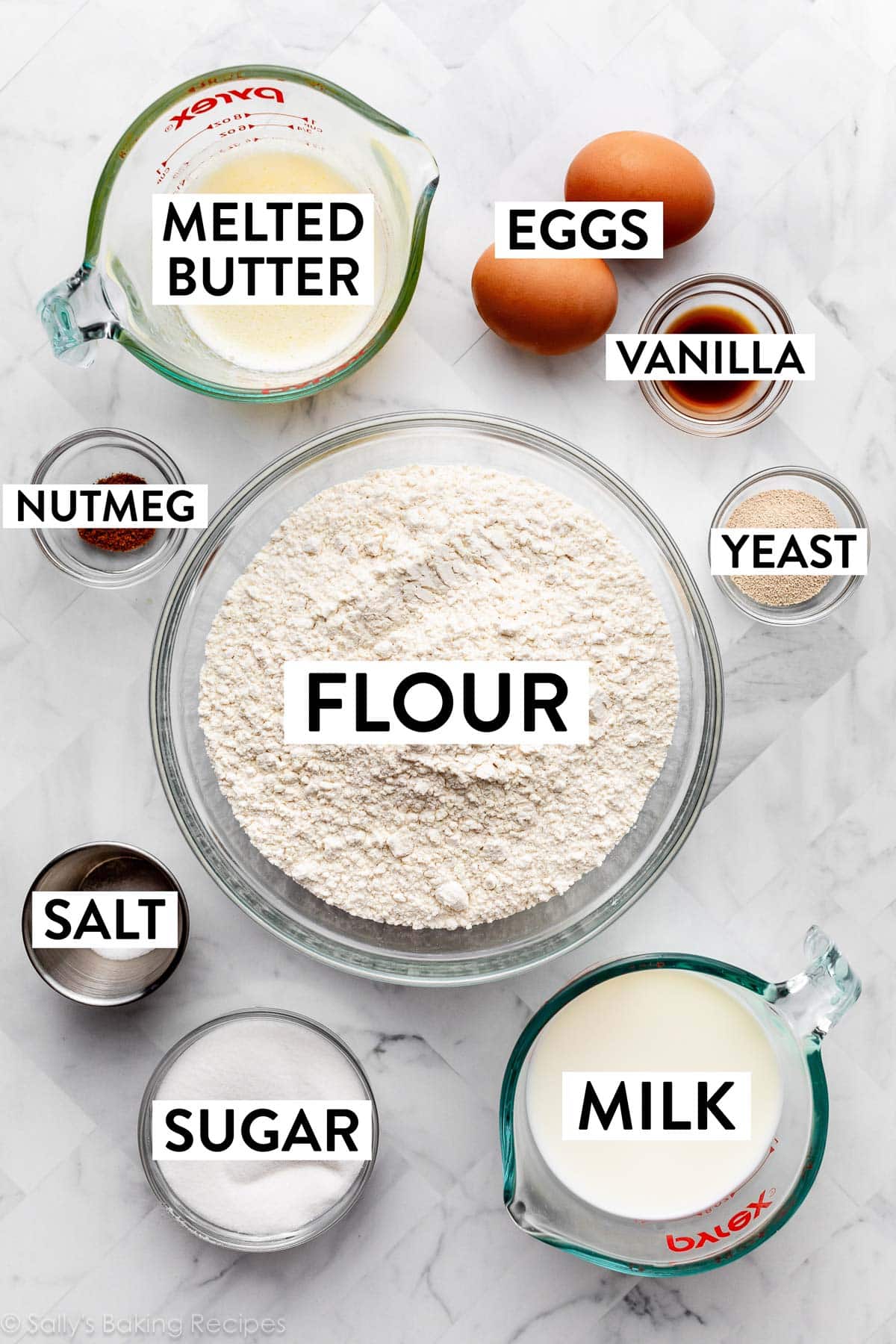
Are You a Yeast Beginner?
Reference this Baking with Yeast Guide whenever you work with baker’s yeast. I include practical answers to all of your common yeast questions.
Overview: How to Make Homemade Glazed Doughnuts
Let me walk you through the process so you understand what you’re doing. Homemade glazed doughnuts seem a little intimidating, but I assure you—they’re really not! I find they’re much easier than, say, homemade bagels and homemade English muffins.
Prepare the dough. The dough comes together with a mixer. You can also make the dough by hand, but it requires a bit of arm muscle. After the dough comes together in the mixing bowl, knead it for 5–7 minutes. If you’re new to yeasted doughs, my how to knead dough post and video can help with this step.
Let the dough rise. In a relatively warm environment, the dough rises in about 90 minutes.
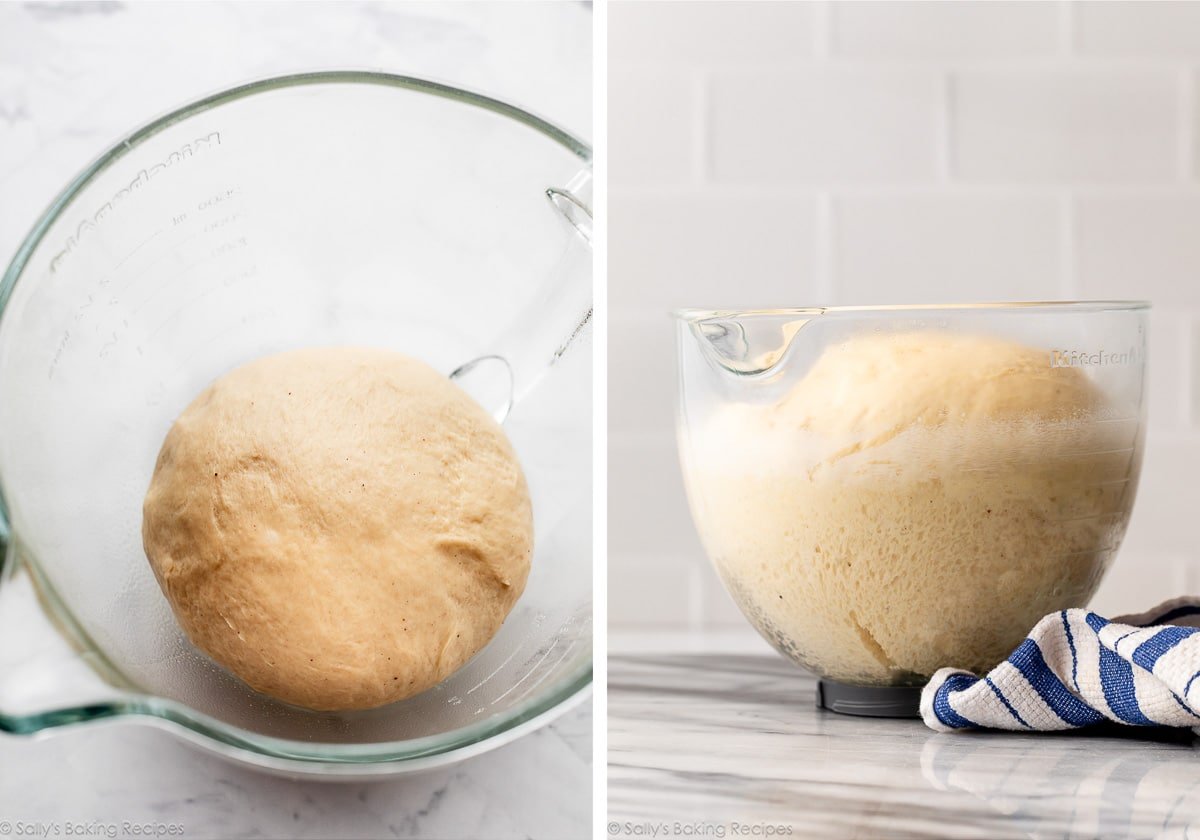
Punch down the dough to release the air.
Roll & cut into doughnuts. Roll the dough out to 1/2-inch thickness. Cut the doughnuts using a 3–3.5-inch doughnut cutter. Line 1 or 2 baking sheets with parchment paper or a silicone baking mat. Place doughnuts (and doughnut holes!) onto the lined baking sheet(s), then lightly cover and allow to rest for 30 minutes as you heat the oil.
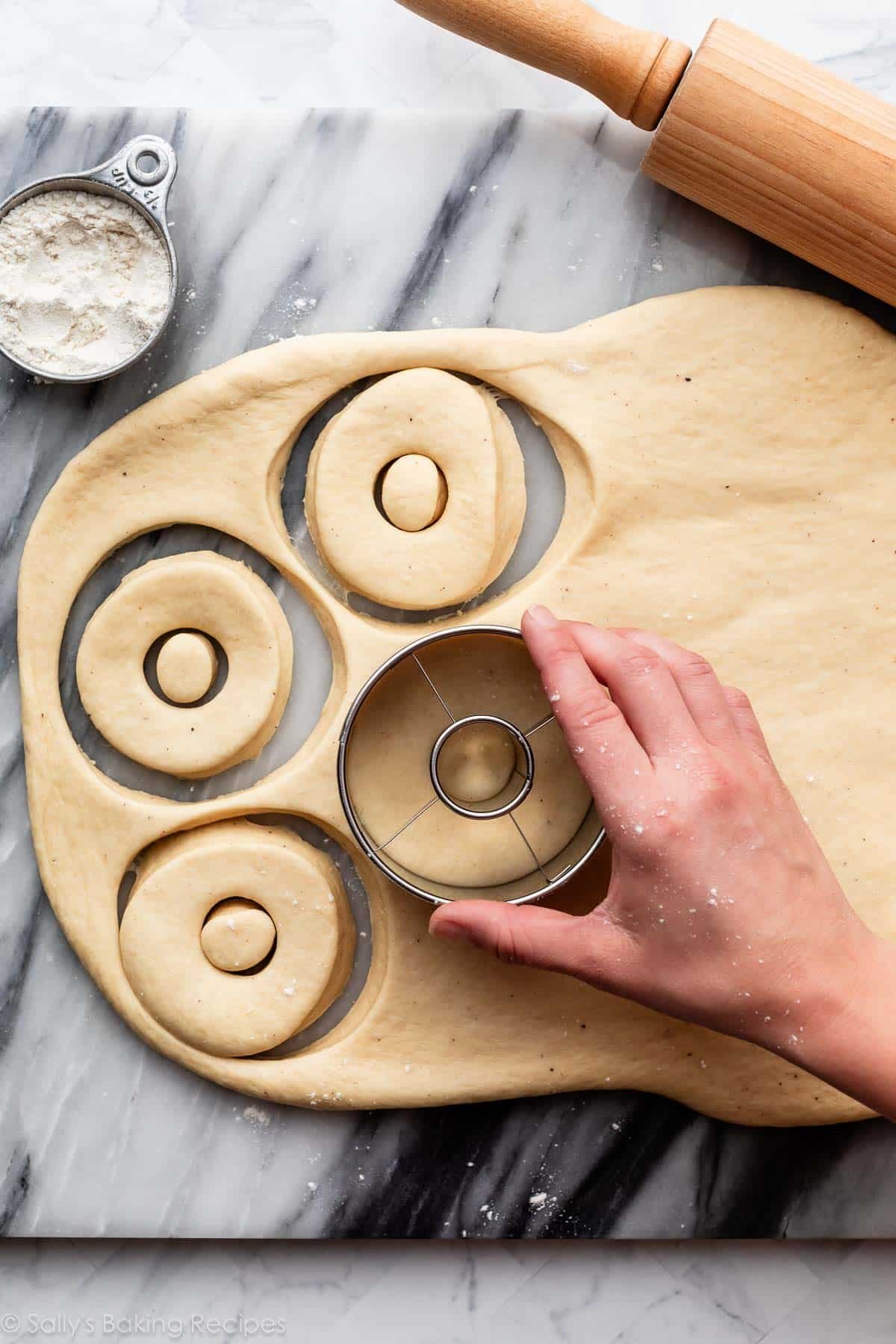
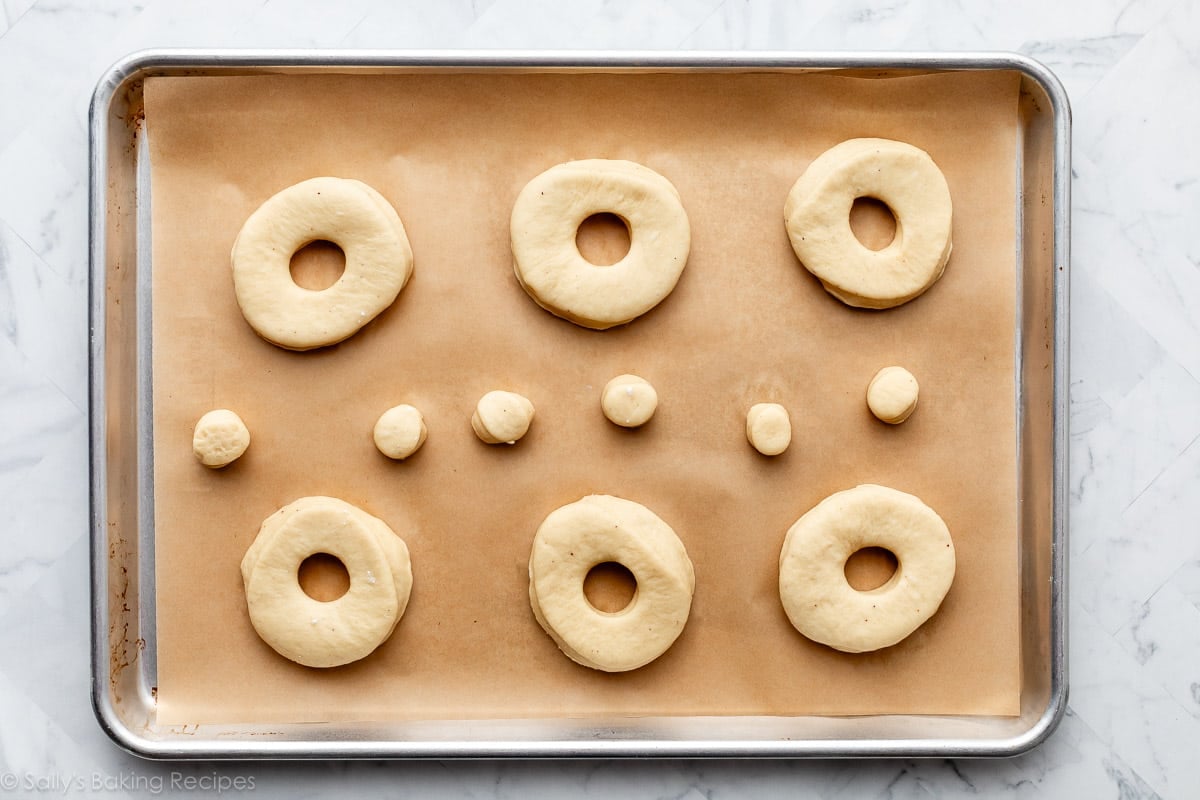
Prepare the oil. Using a heavy-bottomed pot or Dutch oven and an oil thermometer, heat vegetable oil to 375°F (191°C).
Fry the doughnuts. Working with 2–3 doughnuts at a time, cook for 1 minute on each side. Carefully remove from the oil and place onto prepared rack. Repeat with remaining doughnuts. (See my recipe note about making the doughnut holes.)
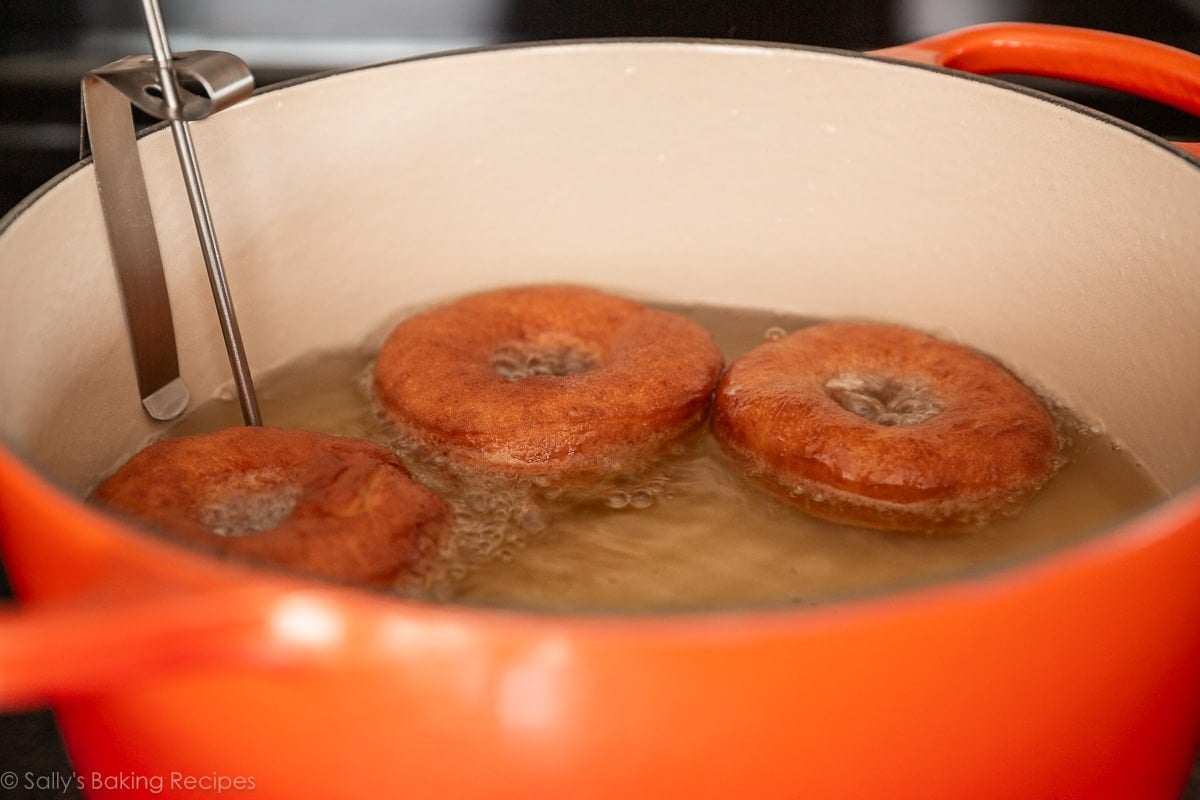
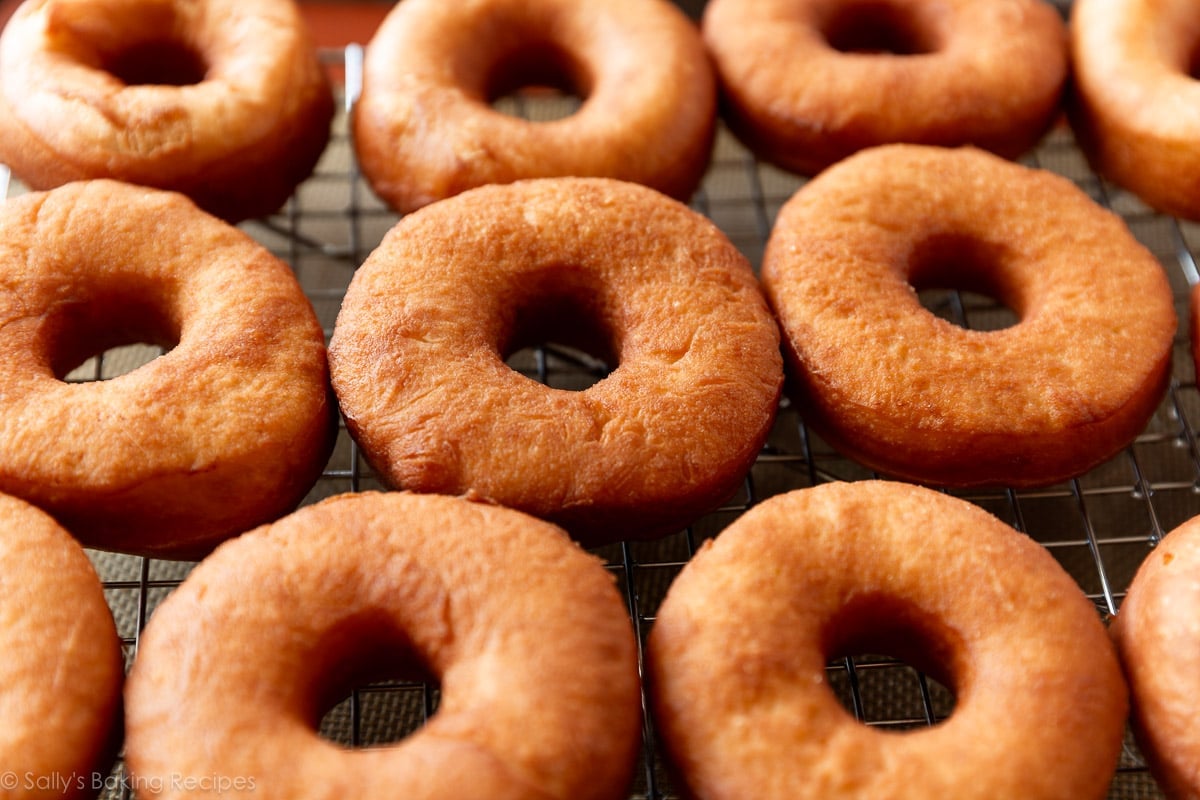
How to Make the Glaze for Donuts
Make a simple 3-ingredient glaze: just milk or cream, confectioners’ sugar, and vanilla extract. This part couldn’t be easier; literally just whisk the 3 ingredients together. Dunk each side of the warm doughnuts into the glaze. The glaze will set in about 20 minutes.
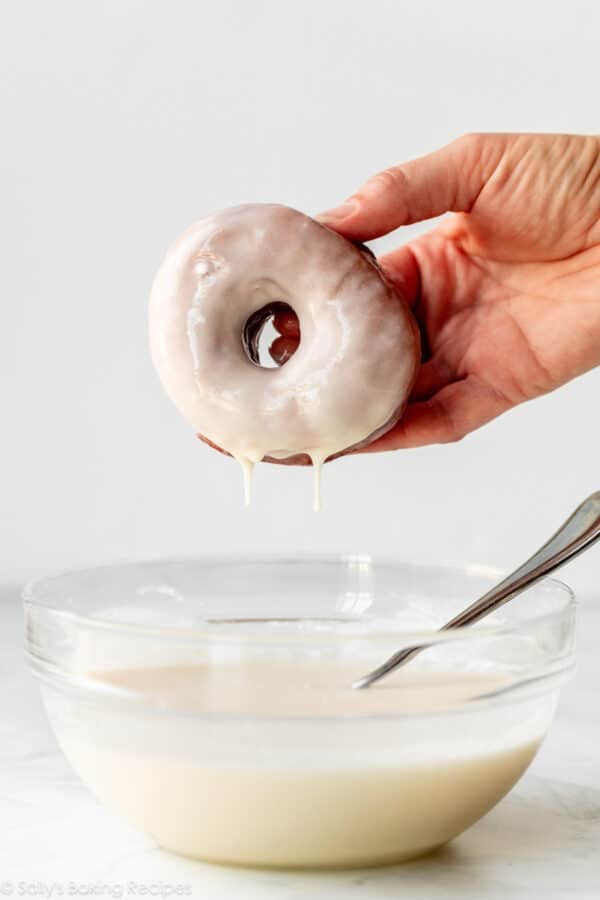
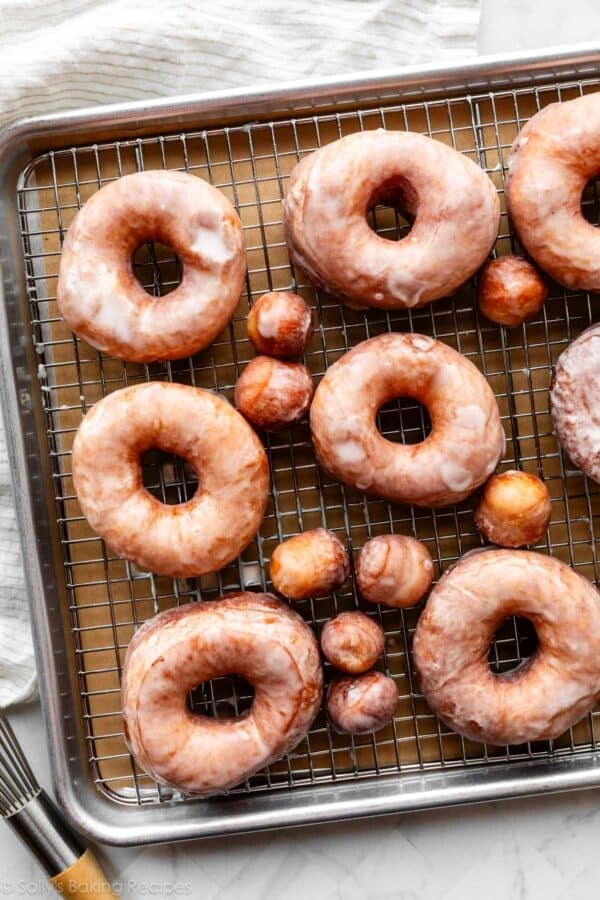
Looking for other flavors? Try my strawberry, chocolate, and vanilla donut frostings or you might enjoy my maple bacon doughnuts!
This Dough Is Best for Frying
I don’t recommend baking this dough—this dough is best for frying in oil. If you’re looking for a baked donut, try crumb cake donuts, pumpkin donuts, cinnamon sugar donuts, or lemon poppy seed donuts instead. Here are all of my donut recipes.
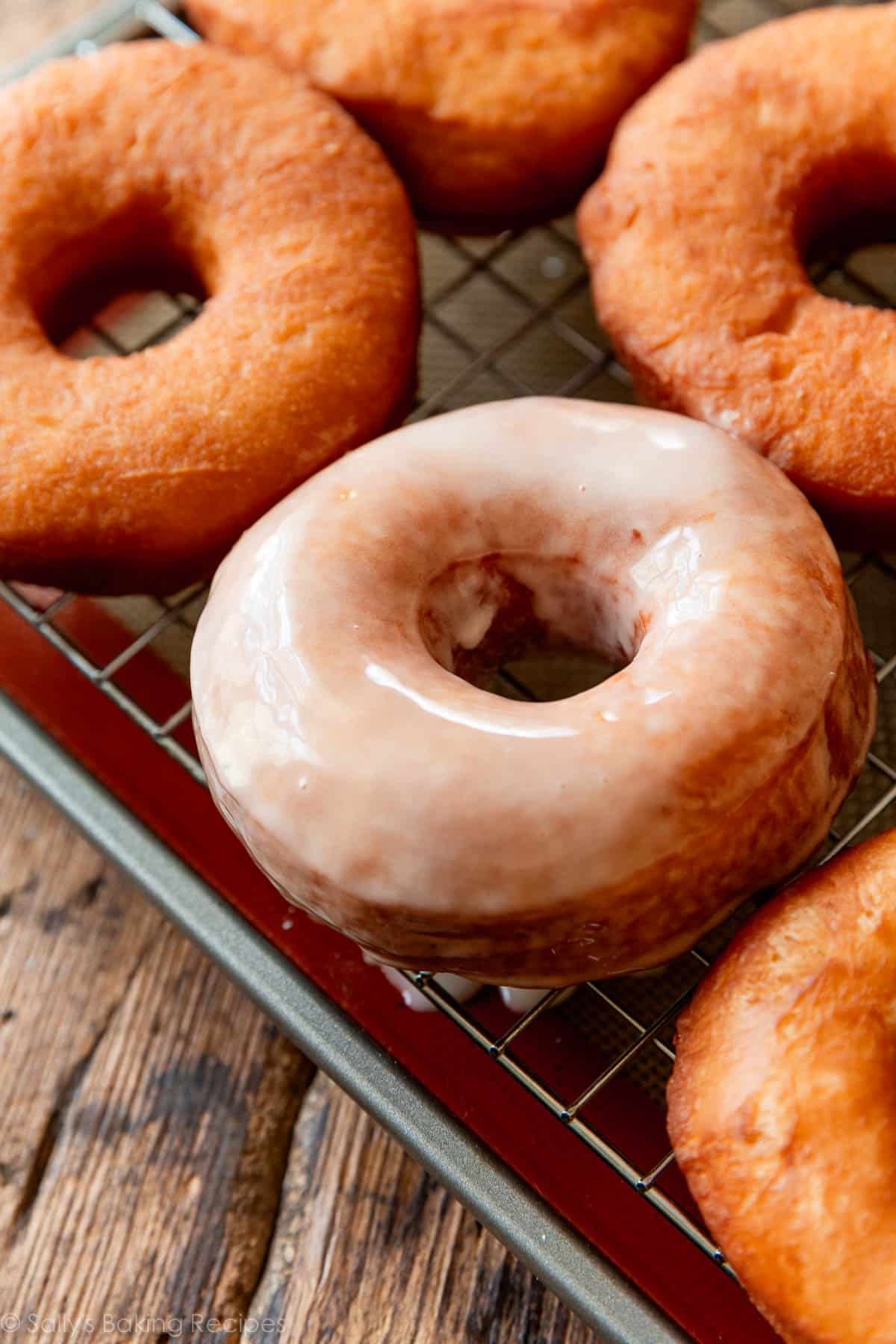
Yes, absolutely. You’ll need a 3-inch biscuit or doughnut cutter without a hole in the center. Use the dough recipe below. Reduce the oil temperature to 350°F (177°C). Fry doughnuts for 1.5–2 minutes on each side, making sure to lower the stove’s temperature if the oil starts to get too hot. Let doughnuts cool for 5–10 minutes before filling. Jams or pastry cream are excellent fillings! Add filling to a piping bag fitted with a long tip such as Ateco 230. Insert the piping tip into the doughnut and fill until the doughnut feels heavy.
This dough is best for frying in oil. You can try using the air fryer, but the donuts will taste more bread-like, and more like baked donuts. For ideal results, I strongly recommend following the recipe.

Homemade Glazed Doughnuts
- Prep Time: 2 hours, 10 minutes
- Cook Time: 10 minutes
- Total Time: 2 hours, 30 minutes
- Yield: 12 donuts and 12 holes
- Category: Breakfast
- Method: Frying
- Cuisine: American
Description
Making homemade glazed doughnuts is easier than you think, but requires a little patience. Ready in about 2.5 hours, these taste like doughnuts from your favorite bakery, but they’re made in the comfort of your own home. For doughnut success, follow my step-by-step photos, helpful success tips, and video tutorial below.
Ingredients
- 1 cup (240ml) whole milk, warmed to about 110°F (43°C)*
- 2 and 1/4 teaspoons (7g) instant or active dry yeast (1 standard packet)*
- 1/3 cup (65g) granulated sugar, divided
- 2 large eggs
- 6 Tablespoons (85g) unsalted butter, melted and slightly cooled
- 1 teaspoon pure vanilla extract
- 1/4 teaspoon ground nutmeg
- 1/2 teaspoon salt
- 4 cups (500g) all-purpose flour (spooned & leveled), plus more as needed
- 1–2 quarts vegetable oil*
Donut Glaze
- 2 cups (240g) confectioners’ sugar, sifted
- 1/3 cup (80ml) heavy cream, half-and-half, or whole milk
- 1/2 teaspoon pure vanilla extract
Instructions
- Prepare the dough: Whisk the warm milk, yeast, and 1 Tablespoon sugar together in the bowl of your stand mixer. Loosely cover and allow to sit for 5–10 minutes until foamy and frothy on top. *If you do not own a stand mixer, you can do this in a large mixing bowl, and in the next step, mix the dough together with a large wooden spoon/silicone spatula. It will take a bit of arm muscle. A hand mixer works, but the sticky dough repeatedly gets stuck in the beaters. Mixing by hand with a wooden spoon or silicone spatula is a better choice.*
- Add the remaining sugar, the eggs, butter, vanilla, nutmeg, salt, and 2 cups (about 250g) flour. Beat on low speed for 1 minute. Scrape down the sides of the bowl with a silicone spatula as needed. Add remaining flour and beat on medium speed until the dough comes together and pulls away from the sides of the bowl, about 2 minutes. If needed, add more flour, 1 Tablespoon at a time, until the dough pulls away from the sides of the bowl. Don’t add too much flour, though. You want a slightly sticky dough.
- Knead the dough: Keep the dough in the mixer and beat for an additional 5-7 full minutes, or knead by hand on a lightly floured surface for 5-7 full minutes. (If you’re new to bread-baking, my How to Knead Dough video tutorial can help here.) If the dough becomes too sticky during the kneading process, sprinkle 1 teaspoon of flour at a time on the dough or on the work surface/in the bowl to make a soft, slightly tacky dough. Do not add more flour than you need because you do not want a dry dough. After kneading, the dough should still feel a little soft. Poke it with your finger—if it slowly bounces back, your dough is ready to rise. You can also do a “windowpane test” to see if your dough has been kneaded long enough: tear off a small (roughly golfball-size) piece of dough and gently stretch it out until it’s thin enough for light to pass through it. Hold it up to a window or light. Does light pass through the stretched dough without the dough tearing first? If so, your dough has been kneaded long enough and is ready to rise. If not, keep kneading until it passes the windowpane test.
- Let Dough Rise: Lightly grease a large bowl with oil or nonstick spray. Place the dough in the bowl, turning it to coat all sides in the oil. Cover the bowl and allow the dough to rise in a relatively warm environment for 1.5–2 hours or until double in size. (For a tiny reduction in rise time, see my answer to Where Should Dough Rise? in my Baking with Yeast Guide.)
- Shape Doughnuts: When the dough is ready, punch it down to release the air. Remove dough from the bowl and turn it out onto a lightly floured surface. Using a rolling pin, roll the dough out until it is 1/2 inch thick. Using a 3–3.5-inch doughnut cutter, cut into doughnuts. Re-roll the scraps and cut more. *If you don’t have a doughnut cutter, you can use 1 large + 1 smaller circle cookie cutter (large should be about 3 and 1/2 inches).
- Line 1 or 2 baking sheets with parchment paper or silicone baking mats. Place doughnuts and doughnut holes on each. Loosely cover and allow to rest for 30 minutes as you heat the oil. They will rise a bit as they rest. Place a cooling rack over another baking sheet.
- Pour oil into a large heavy-duty pot fitted with an oil thermometer. Turn stove on to medium heat. Heat oil to 375°F (191°C). Add 2–3 doughnuts at a time and cook for 1 minute on each side. Carefully remove with a metal slotted spatula or metal slotted spoon. Be sure to lower stove’s temperature if oil temperature is rising; you want it to stay at 375°F (191°C). Wear kitchen gloves if oil is splashing. Place fried doughnuts onto prepared rack. Repeat with remaining doughnuts, then turn off heat.* (See Note for doughnut holes.)
- Make the glaze: Whisk all the glaze ingredients together. Dip each warm doughnut (don’t wait for them to cool!) into the glaze, making sure to coat both sides. Place back onto prepared rack, as excess glaze drips down. After about 20 minutes, the glaze will set.
- Doughnuts are best enjoyed the same day. You can store leftover doughnuts in an airtight container at room temperature or in the refrigerator for another day or two.
Notes
- Freezing Instructions: Prepare recipe through step 5. Freeze shaped doughnuts for up to 3 months. On the day you serve them, let the doughnuts thaw and rest at room temperature for about 4–5 hours. Fry as directed. You can also freeze the fried doughnuts (unglazed). Allow them to cool completely, then freeze for up to 3 months. Thaw in the refrigerator or at room temperature, then reheat as desired (microwave is great) and dunk in freshly made glaze.
- Overnight Instructions: Complete dough through step 3. Instead of allowing to rise in a warm environment in step 4, place the covered dough in the refrigerator overnight (8–12 hours). The next morning, remove from the refrigerator and allow to rise in a warm environment until doubled. The dough will lightly rise in the refrigerator overnight, so the rise the next morning won’t take too long. After rising, continue with step 5.
- Special Tools (affiliate links): Electric Stand Mixer | Large Heavy Bottomed Pot or Dutch Oven | High-Heat Thermometer (I love this thermometer, too) | 3–3.5-inch Doughnut Cutter (I like this one and this one) | Baking Sheets | Silicone Baking Mats or Parchment Paper | Metal Slotted Spatula | Cooling Rack | Glass Mixing Bowl | Whisk
- Doughnut Holes: Add holes to hot oil and fry until golden, about 30 seconds, on each side.
- Milk: Whole milk is a must for the most tender dough—or you can try buttermilk. Lower-fat or nondairy milks work in a pinch, but the doughnuts aren’t as flavorful or rich.
- Yeast: If using an instant yeast, your rise time will be a little shorter. Reference my Baking with Yeast Guide for answers to common yeast FAQs.
- Oil: The amount of oil really depends on how wide or tall your pot is. You want oil to fill about 1/3 of the pot. I use a little more than 1 quart for my 4 and 1/2-quart Dutch oven.
- Leftover Oil: Do not pour used oil down the sink drain. Allow to cool, then pour into an empty container (a funnel is useful here) and discard in the trash or reuse it.
- Adapted from Mark Bittman and Top Pot Doughnuts



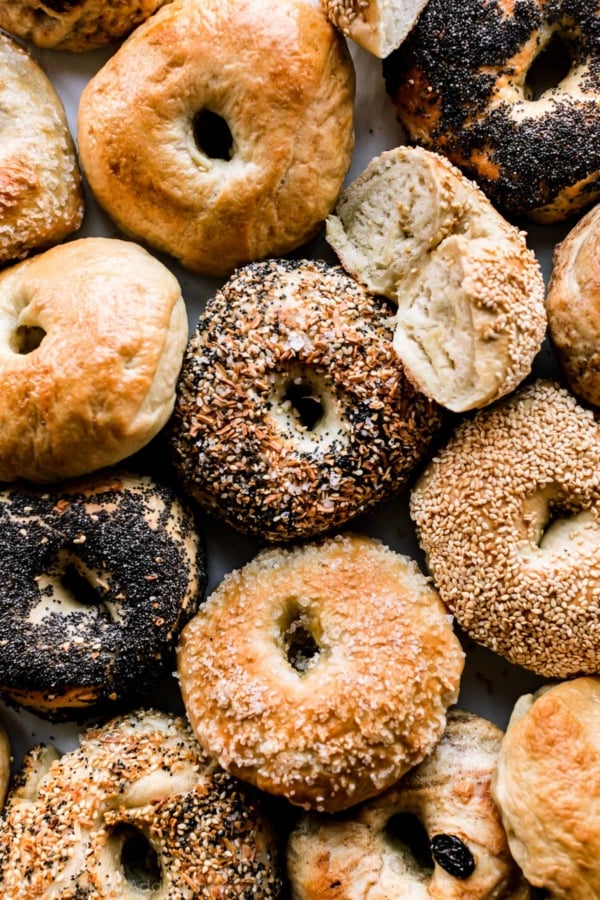













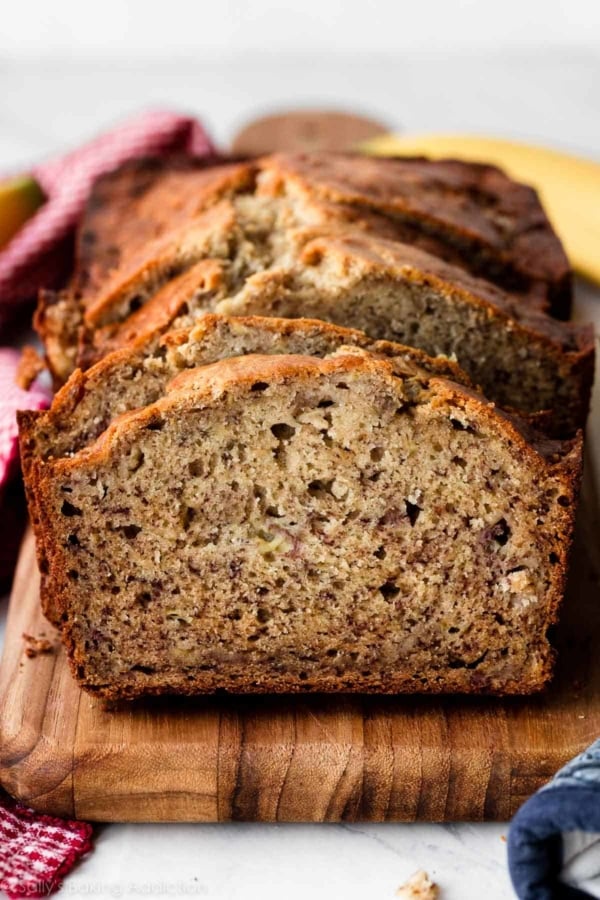

Reader Comments and Reviews
I want to use this recipe but just make doughnut holes. If I use this recipe will it still make 12 doughnut holes or more? I also love your recipes by the way!!
Hi Damriri, We are unsure exactly how many it would make if making all doughnut holes – but it would be a lot! Let us know if you try it.
I will make this recipe tomorrow to make a donut hole tree. I only want to make holes, do you recommend shaping them in little ball (approx 50g) or use the roller + cookie cut them?
Hi Karine! We would cut them. See recipe note #4 for cooking instructions!
This recipe turned out fluffy, flavorful donuts. This is my first attempt at glazed donuts and they were awesome. I followed the recipe exactly and I wasn’t disappointed. Thanks for a fantastic recipe!
I love how they taste. Have made them twice. Mine turned out a bit doughy the first time I made them. This time I made them a bit thinner but they’re still a tad doughy on the inside but better than before. Anything I can do to fix this? I kneaded my dough almost 10 minutes, used the window pane method; let rise for 1 hr 45 min. Fried in veg oil at 375-400 degrees .
Hi Lauren, if they are coming out doughy, it could be that they are overkneaded. Over kneading will cause the dough to collapse when baking and turn out dense. Here is more on how to knead dough, which may be helpful to review before your next batch!
When doing the overnight method, could you say roughly how long the use time is after taking out of the fridge? For example, when I make your cinammon rolls overnight, I take them out 2 hours before baking like clockwork. Is there a similar rule of thumb for the donuts?
Yes, it will be similar!
Awesome, so with cinammon rolls, its bulk rise, form rolls, then refrigerate before another rise. Am I correct in understanding that with donuts, it is dough straight to the fridge, then a 2ish hour bulk rise, then cut the donuts for frying?
I made it with whole wheat flour and added some diastatic malt, and they turned out super fluffy and crispy! I fried them in EVOO to avoid free radicals and you can’t even feel the olive flavor.
Honestly for the effort the flavor is very similar to using canned biscuits, frying them and putting them in the icing. It isn’t good enough to justify the hours extra of work. The instructions could be much more clear. You need to use the bread hook on your mixer. Also it doesn’t say what speed to kneed in your mixer for 5-7 minutes. Absolutely nothing spectacular or delicious about this recipe.
Made these with my daughter. The dough was easy to make and came out light and fluffy after frying. Will be making these again.
This is the second recipe for doughnuts iv tried.and nothing has worked,.the first one i followed the recipe exactly and it was unworkable, looked like runny watery dough and impossible to knead and then I came across yours, I followed again exactly and it was too sticky to knead, I added more flour a bit at a time until it was workable but ended up using nearly a kg of flour in total.
I put it in to prove and nothing happened it stayed a small wet dough. Iv made bread thousands of times and never had a proving problem before
Hi Neil, There are a lot of variables that go into the consistency of dough, even down to the weather and humidity in the air. There’s nothing wrong with adding just a little more flour to bring the dough into a less sticky and knead-able consistency. Keep in mind that you will want a very soft, pillowy dough for the softest doughnuts. If the dough did not rise at all, we wonder if it’s an issue with the yeast. Was it expired, or was the warm milk a bit too hot that it killed the yeast? This Baking with Yeast Guide may also be a helpful resource to review.
Can you let this dough rise overnight and then fry in the morning?
Hi Bambi, see recipe Notes for overnight instructions.
Can I not poke hole and fry them like berliners?
You can! The cook time will be longer.
I’ve been making this recipe for years thanks to you and I love it! At the height of COVID in May 2020, my 3-year-old woke up one morning asking to make donuts. I’d never tried but said “why not?” and a quick Google search led me to you! 5 years later we like to occasionally host donut parties for friends on school breaks. We’re on fall break and will be doing this next week! Thanks for the great recipe and the memories!
They taste amazing best donuts I ever ate thank you Sally!
Can you use vanilla bean paste instead of vanilla extract in this recipe?
Hi Hannah, absolutely! Same amount.
This is the first of your recipes I have been disappointed in. I bake every day, so recipe was followed. Just didn’t feel it really had that “Oh My God” flavor.
How many donuts does this recipe yield?
Hi Maeyda, This recipe yields 12 donuts and 12 holes.
Hi! When you say knead the dough, the step indicates you are using the beater in the stand mixer. Are you using a dough hook attachment or beater for the 5-7 min (of kneading)
Hi Lo, we recommend using the dough hook attachment for kneading in a stand mixer. Happy baking!
First time commenting, but you are my absolute “go to” for anything. Covid sent me into experimenting in the kitchen. And I pushed through the fear into baking.
I made this for the first time today. Been discovering with gluten, so added 1 1/2 tbls to the flour. It is the closest thing to a US donut since moving to Ecuador. Amazing!
You are incredible. Thank you for all your recipes!
Later today – climbing mountain Apple Pie!
We are so happy to read this, L. Jay!
Delicious
My 3.5 year old and I made these. Absolutely incredible!
Love this recipe!! Absolutely delicious!! My family & neighbors want me to make again! Sally, you have never let me down!
I’m impressed and will make the donuts tomorrow morning. We used to use nutmeg too as the spice in our family bakery. I dont have a donut cutter, but will figure something out. Thanks for the inspiration.
My doughnuts came out pretty good, but I really struggled to keep the oil at 375. It would either go way up or way down. Any tips?
Hi Cristina, try to adjust with small increments – it can be tricky!
Use a deep fryer with electronic temperature control